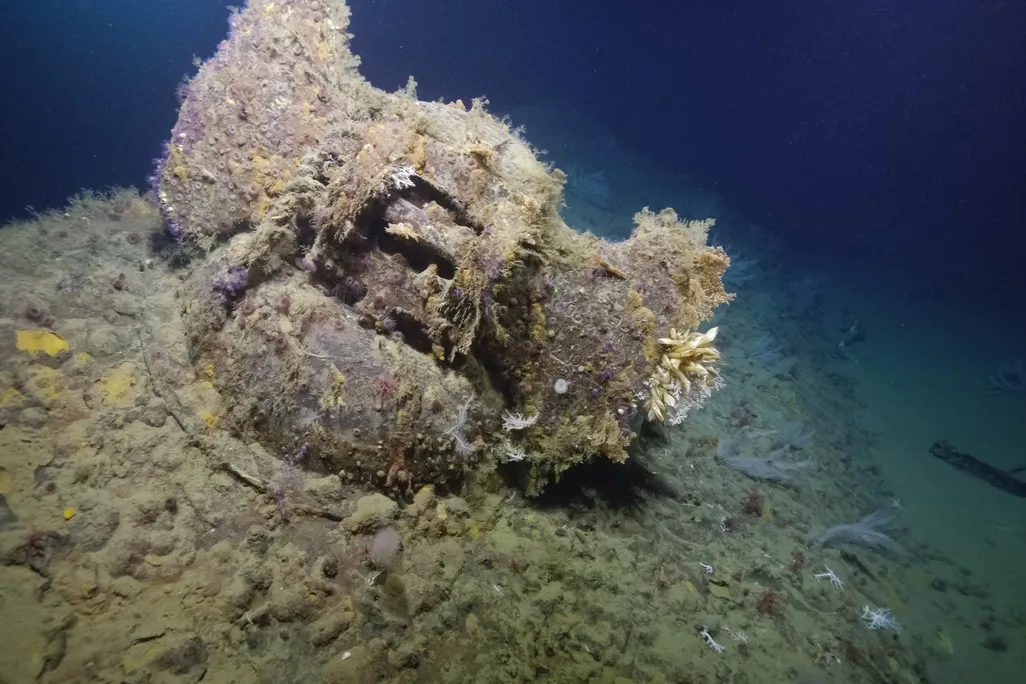Lost Bow of American Warship Found Eight Decades After It Was Blown Off by a Japanese Torpedo in World War II
After the attack, crews sailed the USS “New Orleans” backwards for more than 1,000 miles across the Pacific. Since then, the location of the vessel’s bow has been a mystery

Underwater archaeologists have located the lost bow of the USS New Orleans, a United States Navy cruiser that famously sailed backwards after its bow was blown off by a Japanese torpedo during World War II.
Researchers found the wreckage in the South Pacific Ocean near the Solomon Islands, an archipelago situated northeast of Australia. The bow was discovered during a 21-day expedition carried out by researchers from NOAA Ocean Exploration, the Ocean Exploration Cooperative Institute, the University of New Hampshire and Naval History and Heritage Command.
The USS New Orleans’ bow is submerged 2,214 feet deep near the site of several major naval battles during the Pacific campaign, according to an announcement from the expedition team.
Quick fact: The USS New Orleans’ accolades
The vessel received 17 battle stars, making it one of the most decorated in the Pacific theater.Before World War II, the area was known as Savo Sound. But during the conflict, Allied sailors began calling it “Iron Bottom Sound” because so many warships and planes had sunk there. Between August and December 1942, 111 naval vessels and 1,450 planes from all sides went down in the sound, resulting in more than 20,000 deaths.
More than 180 of those fatalities resulted from a Japanese torpedo strike on the USS New Orleans, which was hit on its portside bow during the Battle of Tassafaronga on November 30, 1942.
The attack ignited some of the ship’s ammunition and blew off the ship’s bow, which accounted for nearly one-third of the 588-foot-long vessel. The surviving crew members sealed off the ship’s bulkheads to prevent water from getting into the rest of the ship, then slowly sailed it to a nearby harbor.
/https://tf-cmsv2-smithsonianmag-media.s3.amazonaws.com/filer_public/94/c0/94c0e1e2-5125-46a7-81b9-80e1044c4724/uss_new_orleans_from_1942.jpg)
Once they arrived, the sailors headed off into the jungle to find logs from coconut trees, which they used to fashion a primitive replacement bow in just 11 days, according to the National WWII Museum in Louisiana. They then steered the ship to Sydney, Australia, for repairs, traveling more than 1,000 miles across the Pacific while sailing backwards, stern first.
“‘Difficult’ does not adequately describe the challenge,” says Carl Schuster, a retired U.S. Navy captain, to CNN’s Brad Lendon.
Meanwhile, the Naval Historical Society of Australia calls it “a remarkable feat of long-distance seamanship.”
/https://tf-cmsv2-smithsonianmag-media.s3.amazonaws.com/filer_public/da/da/dadac595-9ab9-489e-a0c8-df630580c0a7/uss_new_orleans_with_missing_bow_in_tulagi_harbor.jpeg)
Eventually, the ship made it back to America for permanent repairs. Good as new, the USS New Orleans re-entered service until it was decommissioned in 1947, according to the U.S. Naval Institute.
However, for the past 83 years, the location of the USS New Orleans’ bow has been a mystery. Researchers participating in the expedition discovered it by accident, when an uncrewed surface vessel detected an anomaly on the seafloor. The object was too small to be a warship, so researchers sent a remotely operated underwater vehicle down to investigate.
Experts confirmed it was the bow of the USS New Orleans based on the structure, paint and anchor, according to the announcement. Underwater photos and videos show the bow is now home to various coral, anemones, basket stars and other marine creatures. Pieces of modern litter—mostly single-use plastics—have also accumulated at the site, according to the expedition team.
Curious history buffs likely won’t be able to visit the bow in person, as researchers have not revealed its exact location in order to protect the wreckage, per Popular Science’s Andrew Paul. However, starting next year, they can view a new exhibition about the USS New Orleans at the National WWII Museum. Curators plan to display a variety of artifacts, including burned coins found on the deck and a piece of the coconut wood sailors used to make hasty repairs, reports Mark Ballard for the Times-Picayune/New Orleans Advocate.
“By all rights, this ship should have sunk, but due to the heroic damage control efforts of her crew, USS New Orleans became one of the most grievously damaged U.S. cruisers in World War II to actually survive,” says Samuel J. Cox, a retired U.S. Navy rear admiral and director of the Naval History and Heritage Command, in a statement shared with the newspaper.
Finding the bow, Cox adds, is “an opportunity to remember the sacrifice of this valiant crew, even on one of the worst nights in U.S. Navy history.”
/https://tf-cmsv2-smithsonianmag-media.s3.amazonaws.com/accounts/headshot/SarahKuta.png)


